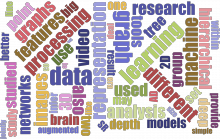MALEGRA - Multimodal Signal Processing and Machine Learning on Graphs

| Type | Start | End |
|---|---|---|
| National | Jan 2017 | Jun 2021 |
| Responsible | URL |
|---|---|
| Javier Ruiz-Hidalgo / Xavier Giró |
Reference
MALEGRA, TEC2016-75976-R, financed by the Spanish Ministerio de Economía, Industria y Competitividad and the European Regional Development Fund (ERDF)
Description
The goal of this project is to study and develop tools combining graph signal representation and processing ideas with machine learning technology. These tools will be used in the context of applications where the size and/or the heterogeneity of the data represent challenges of the Big Data era. The development of technologies related to the capture, storage, search, distribution, transfer, analysis and visualization of ever growing heterogeneous datasets entails tremendous difficulties. At the same time, these difficulties open new opportunities and this development has become a major trend in the field of Information and Communication Technology. The research performed in this project targets applications such as multi-view representations, video analysis, remote sensing for earth monitoring, person identification, health monitoring, medical imaging, genomics, etc.
The project has 4 major objectives. The first two objectives concentrate most of the development of theoretical and basic tools within the project. Within them, we will investigate the creation, analysis, segmentation, filtering and merging of graph structures of heterogeneous multimodal data and on the combination of these ideas with machine learning techniques. This combination with machine learning will be used for several different purposes. In particular, to provide a classification decision, to learn a mapping or a model to be used in a data processing architecture, to learn features that outperform handcrafted equivalents or to aggregate several features to create a signal to be further processed.
The last two objectives of the project focus on the application of the techniques and tools developed in the first two objectives in complex challenges that deal with big and heterogeneous data. In particular, these techniques and tools will be used to study the identification of persons in broadcast TV programs, the optimal encoding of depth maps in multi-view plus depth representations, the radiometric estimation and object detection in SAR and PolSAR images, the classification of multispectral and hyperspectral images, the understanding of brain changes during the evolution of Alzheimers disease, the inference of gene regulatory networks and the segmentation, tracking, indexing and super-resolution of multimodal video sequences.
Publications
|
. Processing Radar Images with Hierarchical Region-Based Representations and Graph Signal Processing Tools. In: Workshop on Digital Topology and Mathematical Morphology associated to the 21st IAPR International Conference on Discrete Geometry for Computer Imagery, Keynote speech. Workshop on Digital Topology and Mathematical Morphology associated to the 21st IAPR International Conference on Discrete Geometry for Computer Imagery, Keynote speech. Paris, France; 2019. |
| . Unsupervised GRN Ensemble. In: Sanguinetti G., Huynh-Thu V. (eds) Methods in Molecular Biology . Vol. 1883. Sanguinetti G., Huynh-Thu V. (eds) Methods in Molecular Biology . New York, NY: Springer science, Humana Press; 2019. pp. 283-302. |
| . Shared latent structures between imaging features and biomarkers in early stages of Alzheimer's disease. In: Workshop on Predictive Intelligence in Medicine (PRIME), MICCAI. Workshop on Predictive Intelligence in Medicine (PRIME), MICCAI. Granada, Spain; 2018. |
| . Monte-Carlo Sampling applied to Multiple Instance Learning for Histological Image Classification. In: Workshop on Deep Learning in Medical Image Analysis, MICCAI. Workshop on Deep Learning in Medical Image Analysis, MICCAI. Granada, Spain; 2018. |
| Identifying the best machine learning algorithms for brain tumor segmentation, progression assessment, and overall survival prediction in the BRATS challenge. In: MICCAI - Multimodal Brain Tumor Segmentation Challenge. MICCAI - Multimodal Brain Tumor Segmentation Challenge. ; 2018. |
|
. SLAM-based 3D outdoor reconstructions from LIDAR data. In: IC3D. IC3D. Brussels, Belgium: IEEE; 2018. |
|
. Recurrent Neural Networks for Semantic Instance Segmentation. In: ECCV 2018 Women in Computer Vision (WiCV) Workshop. ECCV 2018 Women in Computer Vision (WiCV) Workshop. ; 2018. |
|
. UPC Multimodal Speaker Diarization System for the 2018 Albayzin Challenge. In: IberSpeech 2018. IberSpeech 2018. Barcelona; 2018. |
|
. Importance Weighted Evolution Strategies. In: NeurIPS 2018 Deep Reinforcement Learning Workshop . NeurIPS 2018 Deep Reinforcement Learning Workshop . Montreal, Quebec; 2018. |
|
. Demonstration of an Open Source Framework for Qualitative Evaluation of CBIR Systems. In: ACM Multimedia. ACM Multimedia. Seoul, South Korea: ACM; 2018. |
Pages
Collaborators
| Javier Ruiz Hidalgo | Associate Professor | j.ruiz@upc.edu |
| Xavier Giró | Associate Professor | xavier.giro@upc.edu |
| Ferran Marqués | Professor | ferran.marques@upc.edu |
| Albert Oliveras | Associate Professor | albert@tsc.upc.edu |
| Philippe Salembier | Professor | philippe.salembier@upc.edu |
| Elisa Sayrol | Associate Professor | elisa.sayrol@upc.edu |
| Josep R. Casas | Associate Professor | josep.ramon.casas@upc.edu |
| Veronica Vilaplana | Associate Professor | veronica.vilaplana@upc.edu |
| Montse Pardàs | Professor | montse.pardas@upc.edu |
| Marc Maceira | PhD Candidate | marc.maceira@upc.edu |
| Xiao Lin | PhD Candidate | xiao.lin@upc.edu |
| Alba Pujol | PhD Candidate | alba.pujol@upc.edu |
| Adrià Casamitjana | PhD Candidate | adria.casamitjana@upc.edu |
| Albert Gil Moreno | Software Engineer | albert.gil@upc.edu |
